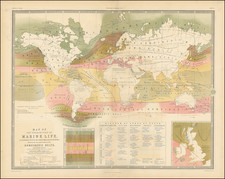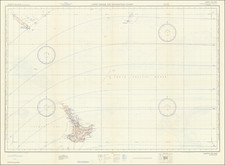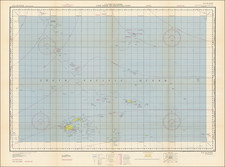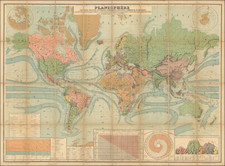Fascinating group of seven maps illustrating the theaters of war during World War II.
During World War II, Remington Rand was renowned for producing thousands of typewriters used by stenographers, clerks, and professionals in the war industry. However, the company’s Library Bureau also published a remarkable set of seven advertising maps, illustrated by Kenneth Thompson and captioned by George Fielding Eliot, a former Major in the U.S. Army Reserve.
These maps, similar in style to the work of aviation-age cartographer Richard Edes Harrison, present each theater of war from an oblique aerial perspective, offering a unique and engaging view that differs significantly from the typical maps seen by the American public. The series includes "Map I – The Russian Front," "Map II – The Balkans," "Map III – Italy & Southern France," "Map IV – The Western Front," "Map V – Southeastern Asia," "Map VI – The Southwest Pacific," and "Map VII – The North Pacific."
Each map meticulously identifies railroads, rivers, and international boundaries, providing a clear and uncluttered view of the scope and topography of each region. The accompanying text, crafted by George Fielding Eliot, offers geopolitical commentary and a strategic overview, drawing from his extensive military experience and insight.
Kenneth Thompson's artistic rendering of relief adds a vivid and dynamic element to the maps, capturing the viewer’s imagination. Thompson's talent (1907-1996) is evident in the detailed and realistic depiction of the varied landscapes. Meanwhile, George Fielding Eliot (1894-1971), a distinguished WWI veteran and military analyst, provides expert analysis. Eliot, who spent his youth in Australia, served in the Australian Infantry during WWI and later in U.S. military intelligence. His extensive knowledge and clear communication style made him a prominent figure during WWII, including his famous extended television broadcast following the attack on Pearl Harbor.
This series of World War II battlefront maps, described as being "for the delight of arm-chair strategists," challenges viewers to reconsider the geopolitical situation through its unusual perspectives—often not orienting north at the top. The strategic and geopolitical insights provided by Eliot, combined with Thompson's artistic cartography, create a powerful tool for understanding the complexities of WWII.













![(Second World War) Your Submarine Versatile Warship [on verso:] NEWSMAP For the Armed Forces 268th Week of the War - 150th of U.S. Participation](https://storage.googleapis.com/raremaps/img/small/95106.jpg)
